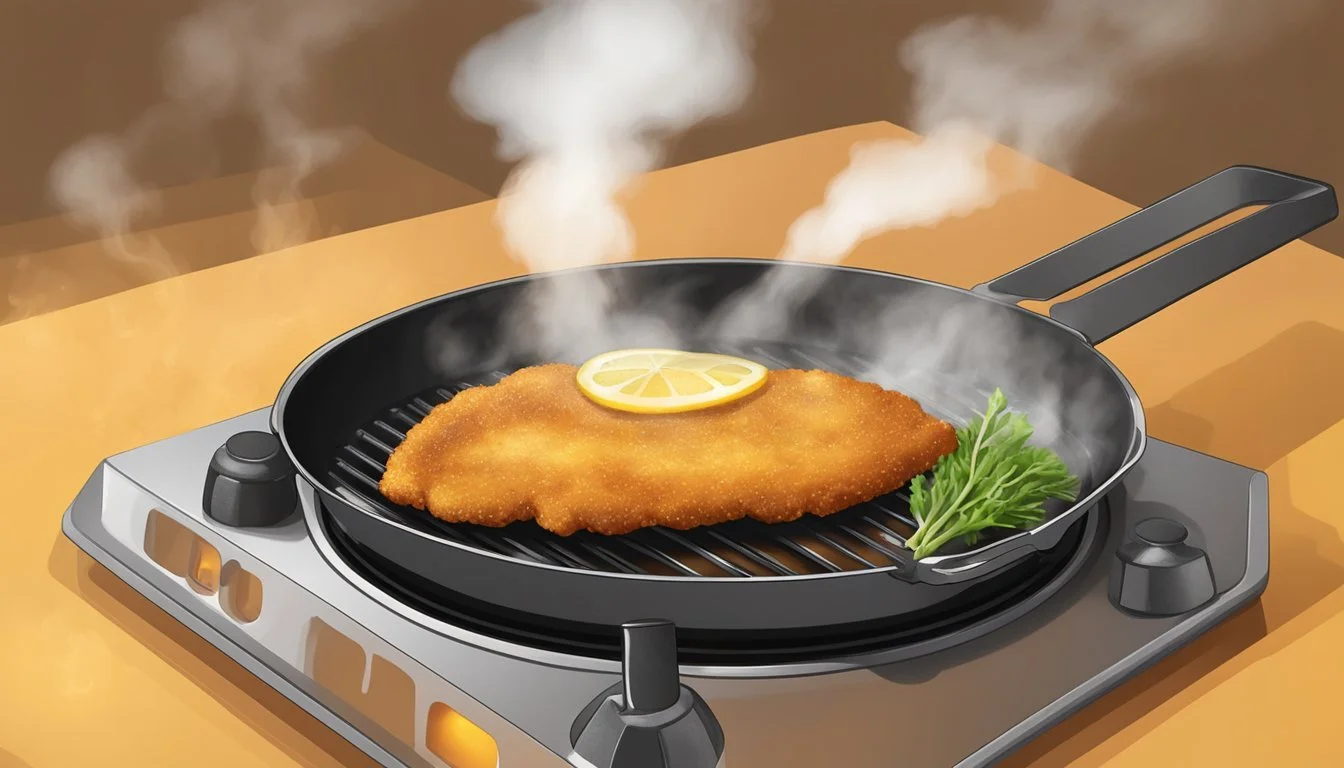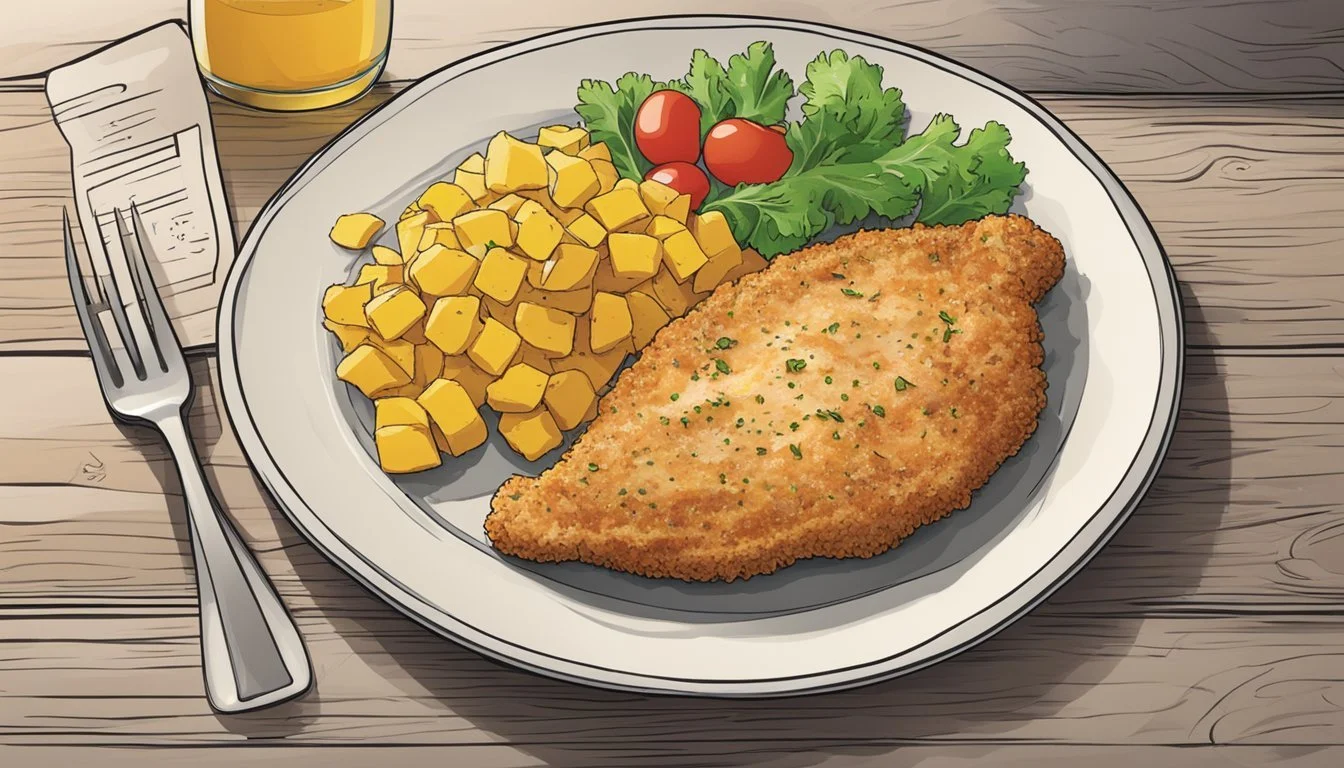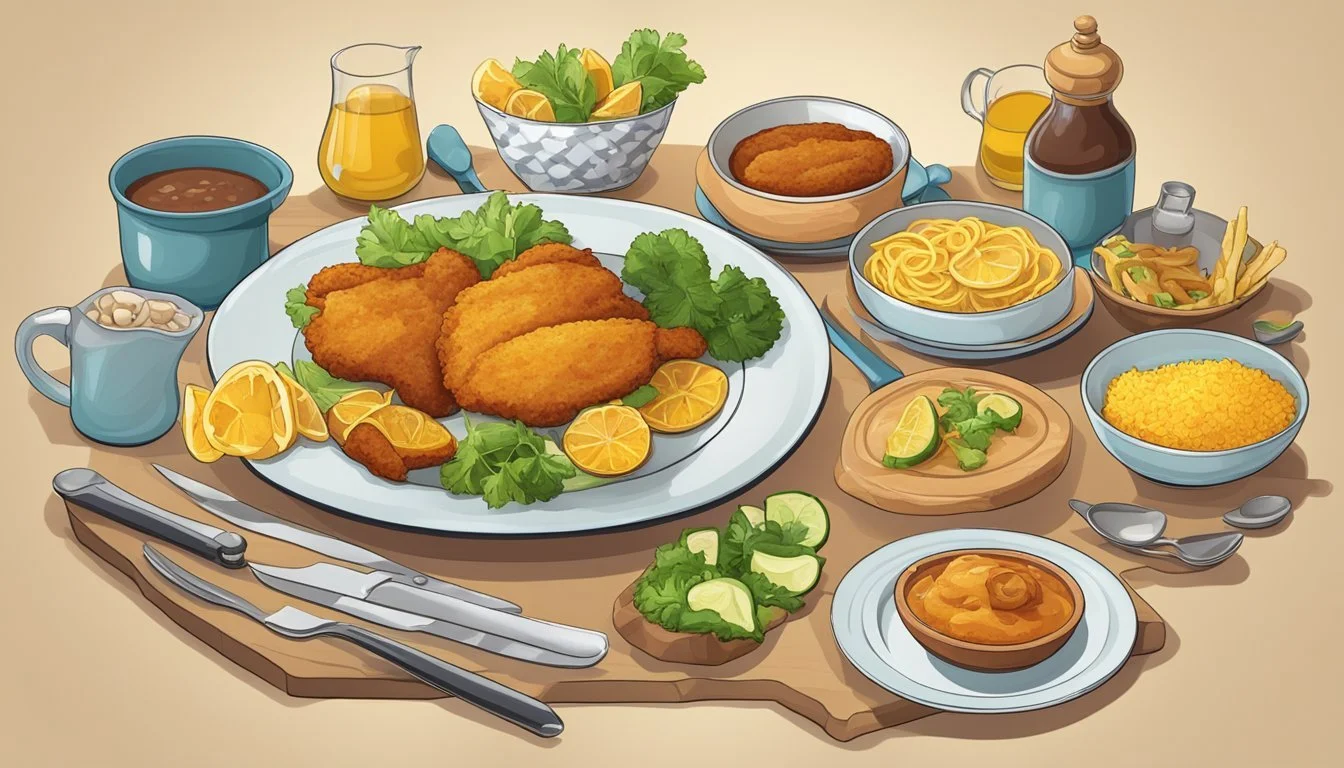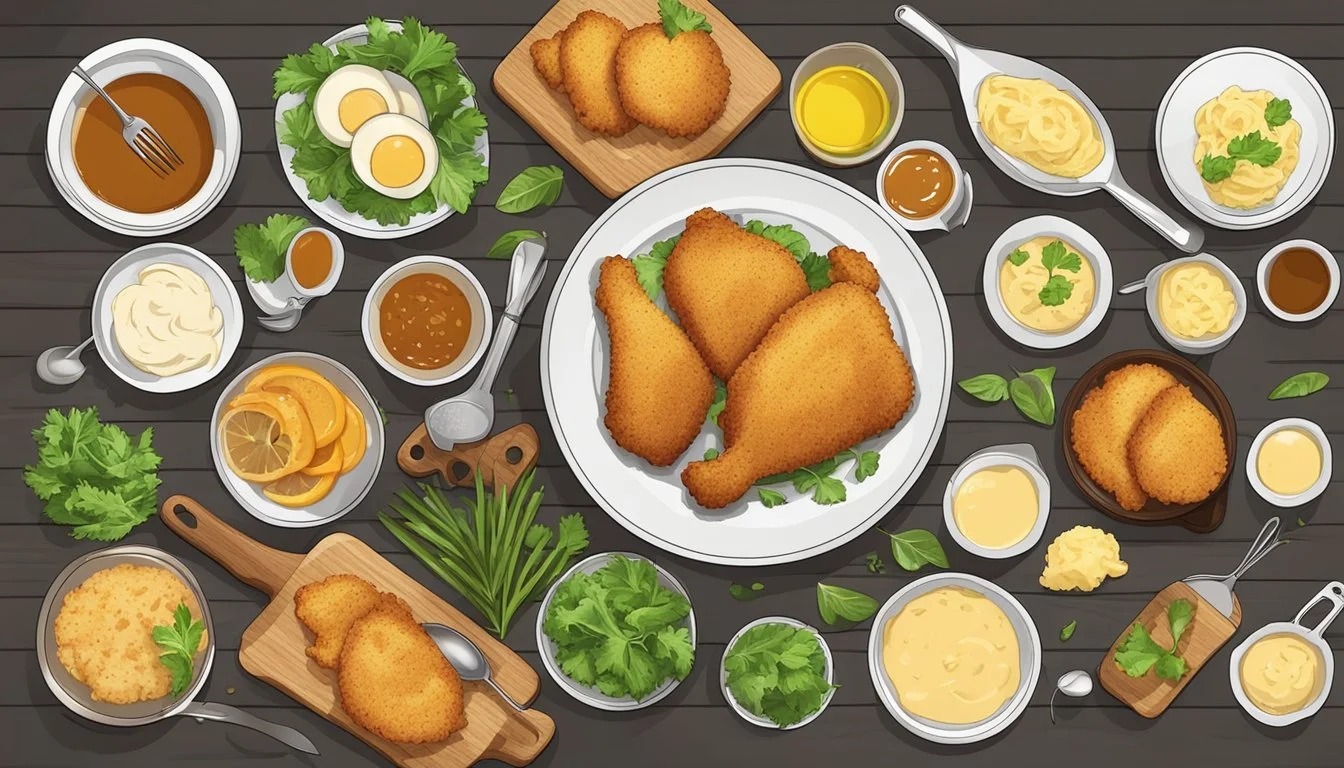How Long Does Chicken Schnitzel Last?
Storage Tips and Shelf Life
Chicken schnitzel, a beloved dish originating from Austria and popularized in countries like Germany and Israel, is a versatile meal enjoyed by many. It combines tender chicken cutlets seasoned with a variety of spices, dredged, and fried to golden perfection. While the recipe might vary slightly, the key to a perfect schnitzel lies in its crispiness and thin, even cooking.
One critical question for any home cook is the shelf life of chicken schnitzel. Properly stored in an airtight container in the refrigerator, chicken schnitzel lasts for 3 to 4 days. This ensures that the chicken remains safe to eat and retains its flavors.
For those interested in meal prepping or making larger quantities, freezing is an excellent option. Frozen chicken schnitzel can last up to 2 months if stored properly, making it convenient for future meals without compromising on taste or texture. With this knowledge, preparing and enjoying this delicious dish becomes not just a culinary delight but also a practical meal option.
Basics of Chicken Schnitzel
Chicken Schnitzel is a popular and delicious dish made from chicken cutlets. Typically, the meat is pounded thin to ensure even cooking and a juicy interior. This tenderization process also helps in achieving a uniform thickness for ease of breading and frying.
The breading process involves three main steps: dredging the chicken in all-purpose flour, coating it in beaten eggs, and finally covering it with breadcrumbs or panko breadcrumbs for added crunch. Panko is often preferred for its light and airy texture, which results in a crispier coating.
A dredging station is essential for efficient preparation. Set up three bowls or plates: one for flour seasoned with salt and black pepper, another for the beaten eggs, and the last for the breadcrumbs or panko.
After breading, the chicken cutlets are typically fried in a pan with hot oil. The oil should be heated to the right temperature to ensure a golden brown crust without making the meat greasy. Lemon wedges are often served on the side for an added burst of freshness.
The use of minimal yet essential seasonings like garlic powder, paprika, and oregano can enhance the flavors. But the true beauty of Chicken Schnitzel lies in its simplicity, making it versatile enough to pair with various side dishes.
Each bite of a properly made Chicken Schnitzel is a delightful combination of crunchy breading and tender, juicy meat, making it a beloved meal in many households.
Proper Storage Techniques
To ensure chicken schnitzel remains safe and delicious, proper storage techniques are crucial. Using refrigeration and freezing methods can significantly extend its shelf life while maintaining quality.
Refrigeration
Refrigerated chicken schnitzel can last for a few days if stored correctly. Place the cooked schnitzel in an airtight container to prevent moisture loss and contamination. The refrigerator should be set at 40°F (4°C) or cooler.
Leftovers should be stored within two hours of cooking. Properly refrigerated schnitzel will remain safe to eat for up to 3-4 days. Write the storage date on the container to keep track of freshness.
Freezing
Freezing is a great method to extend the shelf life of chicken schnitzel for longer periods. First, let the schnitzels cool down completely to avoid condensation inside the packaging.
Individually wrap each piece in plastic wrap or aluminum foil. Then, place them in a freezer bag or airtight container to protect against freezer burn. Label each package with the date before storing.
Frozen chicken schnitzel can last up to 2 months without significant loss in quality. To reheat, thaw it overnight in the refrigerator before reheating it in the oven for the best texture.
Shelf Life and Spoilage Recognition
Chicken schnitzel, like other chicken dishes, needs careful storage to prevent spoilage and ensure safety. It’s important to know the shelf life both in the fridge and freezer, and understand how to recognize signs of spoilage.
In the Fridge
Chicken schnitzel should be stored in the refrigerator at or below 40°F (4°C). Cooked chicken schnitzel can last 3-4 days if refrigerated properly. It is best to store it in airtight containers or wrap it securely in plastic wrap or aluminum foil.
To retain quality, it is crucial to store the schnitzel promptly after cooking. Leaving it at room temperature for more than two hours increases the risk of bacterial growth. Marking the storage date helps keep track of how long the chicken schnitzel has been stored.
In the Freezer
Freezing chicken schnitzel can extend its shelf life significantly. Cooked chicken schnitzel maintained at 0°F (-18°C) or below remains safe for about 2-3 months. Proper packaging is key: Use heavy-duty aluminum foil, freezer paper, or airtight containers designed for freezing.
Before freezing, ensure the schnitzels are cooled completely to avoid condensation. Label the packaging with the date to monitor how long it has been frozen. While freezer burn may affect taste and texture, it does not pose a health risk.
Signs of Spoilage
Recognizing spoilage in chicken schnitzel is essential to prevent foodborne illness. Spoiled chicken schnitzel might display several signs, such as a sour or rancid smell. Check for any change in color—grayish or greenish hues indicate spoilage.
Texture changes, such as a slimy or sticky feel, also suggest spoilage. Mold growth on the surface is an obvious sign that the chicken schnitzel is no longer safe to eat. Any of these signs mean the schnitzel should be discarded immediately to avoid health risks.
Cooking and Reheating Methods
Knowing the best methods for cooking and reheating chicken schnitzel will help ensure it maintains its crispy texture and juicy interior. Below are three effective methods you can use.
In the Oven
Using an oven is ideal for reheating chicken schnitzel while keeping it crispy. Preheat the oven to 350°F (175°C). Place the schnitzel on a wire rack set over a baking sheet to promote even heating. This setup prevents the schnitzel from getting soggy by allowing excess oil to drip away. Heat the schnitzel for 10-15 minutes, flipping halfway through. This method retains the crunchiness of the coating and heats the meat evenly.
On the Stovetop
Reheating chicken schnitzel on a stovetop ensures a quick and flavorful result. Allow the schnitzel to reach room temperature. Heat a skillet over medium heat and add a small amount of oil. When the oil is hot, add the schnitzel. Cook it for about 2 minutes per side. This method will give the schnitzel a freshly-fried taste and maintain its crispy exterior. It's best to place the cooked schnitzel on a paper towel to absorb any excess oil.
Using an Air Fryer
An air fryer is another excellent option for reheating chicken schnitzel. Preheat the air fryer to 375°F (190°C). Place the schnitzel in the air fryer basket, making sure they do not overlap. Cook for 5-7 minutes, flipping once halfway through. This method is efficient and helps retain the schnitzel's crunchiness without requiring much oil. It's quick and convenient, especially for smaller portions.
These methods ensure that chicken schnitzel remains delicious, crunchy, and juicy, making it a pleasure to enjoy even as leftovers.
Nutritional Information
Chicken schnitzel is a popular dish made from breaded and fried chicken cutlets. It provides a substantial amount of nutrients, which can be broken down into various components.
A typical serving of chicken schnitzel (about 317.73 grams) contains approximately 667.2 calories.
The calories come from different sources:
Protein: A significant part of the calories is from protein. A serving provides around 30-35 grams of protein, making it a good source for muscle repair and growth.
Fats: It also contains about 30.5% of the total calories from fats, which includes both saturated and unsaturated fats.
Carbohydrates: Approximately 22% of the calories in chicken schnitzel come from carbohydrates, primarily from the breading.
Nutritional Breakdown (Per Serving):
Nutrient Amount Calories 667.2 kcal Protein 30-35 g Fats ~203.6 kcal Carbohydrates ~22% of total
Chicken schnitzel also includes vitamins and minerals such as B vitamins, iron, and zinc, contributing to its nutritional value.
Eating chicken schnitzel can be part of a balanced diet when consumed in moderation. However, due to its preparation method, it tends to be higher in fats and calories compared to other chicken dishes.
Preparing the Perfect Chicken Schnitzel
To prepare chicken schnitzel, start by using chicken breasts. Slice them into thin cutlets. Place each cutlet between sheets of plastic wrap or in a resealable freezer bag. Use a meat mallet or rolling pin to pound the chicken to an even thickness, about 1/4 inch. This ensures they cook evenly.
Season the chicken lightly with salt and pepper. Preparing a breading station helps streamline the process. Arrange three bowls: one with flour, another with beaten eggs, and the third with panko bread crumbs.
Dredge the chicken cutlets first in the flour, shaking off the excess. Dip them in the beaten eggs, making sure they are well-coated. Then press them into the panko bread crumbs, ensuring an even coating for a crispy exterior.
Heat about half an inch of vegetable oil in a large skillet over medium-high heat. Carefully lay the breaded cutlets in the hot oil. Cook for 2-3 minutes per side until golden and crispy.
Remove the schnitzel from the skillet and transfer to a plate lined with paper towels. Allow any excess oil to drain. To ensure the tender meat is cooked through, use a meat thermometer to check that the internal temperature has reached 165°F (74°C).
Serve immediately for the best texture and flavor.
Serving Suggestions
Chicken schnitzel pairs wonderfully with a variety of side dishes and presentations. The right accompaniments and presentation can enhance its flavor and make for a delightful meal experience.
Accompaniments
Several side dishes enhance the taste of chicken schnitzel. Mashed potatoes or German potato salad are traditional choices that provide a comforting, hearty component.
Fries offer a crispy contrast and are often favored for their simplicity. For a lighter option, a green salad with fresh lettuce, cucumber, and cherry tomatoes is a refreshing choice. Coleslaw gives a tangy crunch that pairs well with the schnitzel's crispy texture.
Adding a few lemon wedges on the side is common, as a squeeze of lemon can brighten up the dish. Veggies like steamed broccoli or cucumber salad can also complement the schnitzel, adding color and freshness to the plate.
Presentation
Thoughtful presentation can enhance the appeal of chicken schnitzel. Arrange it on a plate with the accompaniments strategically placed around it. For example, serve mashed potatoes with a small well of gravy in the center.
Place lemon wedges neatly on the side for easy access. A side salad or coleslaw can be presented in a small bowl or as a small mound next to the schnitzel.
For a unique variation, consider serving the schnitzel in a sandwich with a pickle spear on the side. Ensure the plate is clean and the components are well-spaced to avoid overcrowding, which maintains an inviting look.
Cultural Significance
Wiener schnitzel is a renowned Austrian dish that has a significant cultural impact. Traditionally made with veal, it is a staple in Austrian cuisine and has been deeply embedded into their culinary traditions. Wiener schnitzel is often served with potato salad or lingonberry sauce, emphasizing its importance in both everyday meals and festive occasions.
Chicken schnitzel, while similar, has broader appeal and is popular beyond Austria. Originating from Germany, it involves breaded and fried chicken cutlets. The popularity of chicken schnitzel has led to its adaptation in various cultures, embracing it into their gastronomic practices.
Milanese, an Italian counterpart to schnitzel, is typically made with veal or chicken. Originating from Milan, this dish often includes optional toppings like tomato sauce and melted cheese, highlighting its Italian roots. It’s commonly accompanied by salads or pasta, reflecting its integration into Italian culinary culture.
Table: Key Differences
Dish Origin Traditional Meat Common Sides Wiener Schnitzel Austria Veal Potato salad, lingonberry sauce Chicken Schnitzel Germany Chicken Varies widely Milanese Italy Veal or Chicken Salad, pasta
Pork schnitzel is another variation, especially popular in Germany and Austria. It’s made using pork cutlets and follows a similar preparation method to veal and chicken schnitzel. This variation underscores the adaptability of schnitzel to different cultural tastes and preferences.
Through these adaptations, schnitzel in its various forms has maintained a strong cultural presence across several European cuisines, demonstrating its versatile appeal and enduring cultural significance.
Recipe Variations and Substitutions
Chicken schnitzel variations can offer a variety of flavors and dietary options.
To start, seasonings like paprika, garlic powder, and dried oregano can be mixed with flour for a flavorful coating.
Adding parmesan to breadcrumbs provides a cheesy crust.
Both sesame seeds and panko breadcrumbs create a crunchy texture.
For frying, oils like olive oil, avocado oil, and canola oil work well.
For a lighter option, choose light olive oil.
Gluten-free breadcrumbs can be used for those with dietary restrictions.
Adding Dijon mustard to the egg mixture imparts a tangy note. Sea salt or kosher salt can be used depending on preference.
To serve, consider sides like lemon juice, green beans, arugula salad, pickle slices, and fresh parsley.
Make-ahead options include preparing the chicken and storing in the fridge before frying. This makes meal prep easy.
These substitutions ensure a dish that's adaptable to various tastes and dietary needs.
Frequently Made Mistakes
Many cooks make several common errors when preparing chicken schnitzel. Overcooking is a significant issue that results in dry, tough chicken. It's crucial to monitor cooking time closely and use a meat thermometer to ensure the internal temperature reaches 165°F without exceeding it.
Underseasoning can leave the schnitzel bland and unappealing. Proper seasoning involves not just salting the chicken but also the flour, eggs, and breadcrumbs to ensure flavor at every layer.
The oil temperature is another critical factor. If the oil is too hot, the schnitzel can burn on the outside while remaining undercooked inside. Conversely, if the oil is too cool, the breading can absorb too much oil and become greasy. Aim for an oil temperature of around 350°F.
Inadequate breading happens when the coating doesn't fully adhere to the chicken. This can be due to skipping the resting phase after breading the chicken or not pressing the breadcrumbs firmly enough. Ensuring each layer sticks well is crucial for a crispy, even coating.










